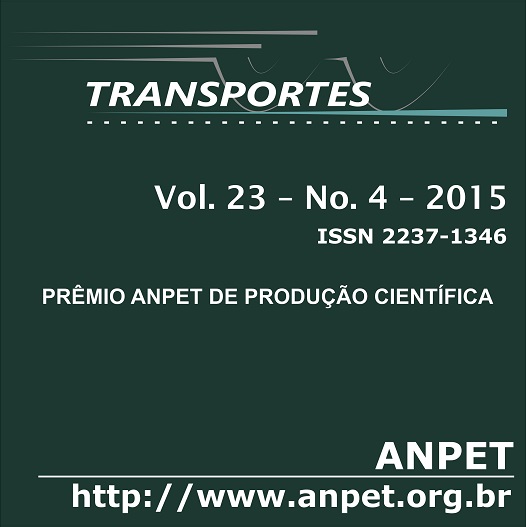...
DOI:
https://doi.org/10.14295/transportes.v23i4.981Keywords:
Railroad ballast. Life Cycle CostAbstract
In the last decade the management of railway infrastructure in Brazil had major changes compared to the previous decades. The increased volume of goods transported demanded the restructuring of railways and infrastructure management became an important issue. In response the railways began working with quantitative analysis of the impacts of decisions on maintenance to ensure the quality of infrastructure in the long term and sustain your budget needs. In this paper an approach based on life cycle cost of the ballast due to changes in the assumptions of the undercut cycle and tamping cycle in order to propose an economic strategy for the asset maintenance at Estrada de Ferro Vitoria Minas (EFVM). The studies have reported that the renewal solution with 50% of ballast is the most economical and the main costs involved are stopped train hours and tampingDownloads
References
Associação Brasileira de Normas Técnicas. NBR 5.564: Via Férrea – Lastro-Padrão. Associação Brasileira de Normas Técnicas, Rio de Janeiro, 2011.
Anderson, W. F.; Fair, P. Behavior of railroad ballast under monotonic and cyclic loading. Journal of Geotechnical and Geoenvironmental Engineering, v. 134, n. 3, 2008. DOI: 10.1061/(ASCE)1090-0241(2008)134:3(316).
Borts, G.H. The Estimation of Rail Cost Functions. The Econometric Society, New York, NY, U.S.A, 1960.
Burkett G. Crash Attenuator Usage Along 9 Travel Ways and in Work Zones, July 16, 2010. Advanced Highway Maintenance and 10 Construction Technology Research Center, Department of Mechanical and Aerospace 11 Engineering, University of California at Davis. http://ahmct.ucdavis.edu/pdf/UCD-ARR-12 10-07-16-01.pdf.
Acesso em: 13/08/2013.
Diyaljee, V. A.: Effects of stress history on ballast defor-mation. Journal of the Geotechnical Engineering, ASCE, v. 113, n.8, 1987, p. 909–914.
DOI: 10.1061/(ASCE)07339410(1987)113:8(909)
EN 13.450. Aggregates for Railway Ballast. European Standard - European Committee for Standardization, Brussels, Belgium, 2002.
Feldman, F.; Nissen, D. Alternative Testing Method for the Measurement of Ballast Fouling: Percentage Void Con-tamination. Conference on Railway Engineering, RTSA, 101-109, Wollongong, Australia, 2002.
DOI: 10.3850/978-981-07-4948-4_331
Griliches, Z. Cost Allocation in Railroad Regulation. Bell Journal of Economics and Management Science, v.3, n.1, p. 26-41, Australia, 1972.
Indraratna, B., Nimbalkar, S., Christie, D., Rujikiatkam-jorn, C., Vinod, J. Field assessment of the performance of a balasted rail track with and without geosynthetics. Jour-nal of the Geotechnical and Geoenvironmental Engineer-ing, v. 136, n. 7, 2010b, p. 907-917.
DOI: 10.1061/(ASCE)GT.1943-5606.0000312
Keeler, T. Railroad Costs, Returns to Scale, and Excess Capacity. Review of Economics and Statistics, v.56, n.2, p. 201-208, Cambridge, U.S.A, 1974.
Korpi E., Life cycle costing: a review of published case studies, Managerial Auditing Journal, v. 23 n. 3, p.240 – 261, 2008. DOI: 10.1108/02686900810857703
Oum, T.H., W. A Survey of Recent Developments in Transportation Cost Function Research. Logistics and Transportation Review, 1996.
Profillidis, V.A. The Mechanical Behaviour of the Railway Sleeper, Rail International, 1, 25-33, 2001.
Selig, E. T., Waters, J. M. Track Geotechnology and sub-structures Management. Thomas Telford Services Ltd., Londres, 79, 1994.
Selig, E.T., B.I. Collingwood, and S.W. Field, Causes of Fouling in Track. AREA Bulletin 717, 1988.
Waters, W.G. II. Rail Cost Analysis. Chapter 5 in Interna-tional Railway Economics (eds. K.J. Button and D.E. Pit-field), Gower Publishing, Aldershot, UK, p. 101-135, 1985.
Zhang, H.; Keoleian, G.A and Lepech, M.D. “An integrat-ed life cycle assessment and life cycle analysis model for pavement overlay systems”. Life Cycle Civil Engineering. 2008. DOI: 1680/geot.2007.57.6.527
Downloads
Published
How to Cite
Issue
Section
License
Authors who submit papers for publication by TRANSPORTES agree to the following terms:
- The authors retain the copyright and grant Transportes the right of first publication of the manuscript, without any financial charge, and waive any other remuneration for its publication by ANPET.
- Upon publication by Transportes, the manuscript is automatically licensed under the Creative Commons License CC BY 4.0 license. This license permits the work to be shared with proper attribution to the authors and its original publication in this journal.
- Authors are authorized to enter into additional separate contracts for the non-exclusive distribution of the version of the manuscript published in this journal (e.g., publishing in an institutional repository or as a book chapter), with recognition of the initial publication in this journal, provided that such a contract does not imply an endorsement of the content of the manuscript or the new medium by ANPET.
- Authors are permitted and encouraged to publish and distribute their work online (e.g., in institutional repositories or on their personal websites) after the editorial process is complete. As Transportes provides open access to all published issues, authors are encouraged to use links to the DOI of their article in these cases.
- Authors guarantee that they have obtained the necessary authorization from their employers for the transfer of rights under this agreement, if these employers hold any copyright over the manuscript. Additionally, authors assume all responsibility for any copyright infringements by these employers, releasing ANPET and Transportes from any responsibility in this regard.
- Authors assume full responsibility for the content of the manuscript, including the necessary and appropriate authorizations for the disclosure of collected data and obtained results, releasing ANPET and Transportes from any responsibility in this regard.










